
Rediscovering Japan

Rediscovering Japan
Travel (Jomon Sites of Aomori Prefecture Part 1 (Tsugaru)

by tomizuta
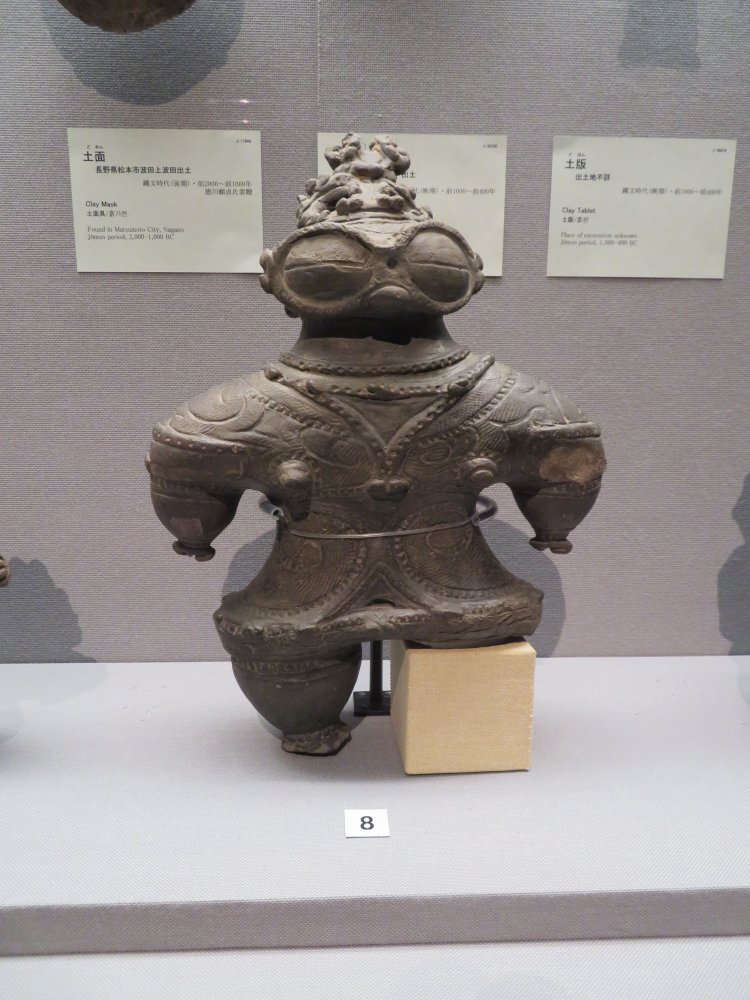
The goggle-eyed clay figurine (an important cultural property dated between 1000 to 400 B.C.) excavated from the Kamegaoka Jomon site in Aomori Prefecture was on display at the Tokyo National Museum in Ueno, Tokyo. I took this photo with the help of a museum curator in February 2021 during a Jomon exhibition.
Having visited the Neolithic Jomon era sites in the vicinity and read a couple of books (it is amazing how many books on Jomon are around), I was longing to visit the San-nai Maruyama archaeological site not that far from central Aomori City. The site discovered in 1992 “is an archaeological site of a large-scale settlement which thrived approximately from 3,500 BC and suddenly ended around 2,000 BC. It is one of the largest remains of a settlement from the Jomon era in Japan.” (from Aomori Prefecture’s Sightseeing Guide) This was mid-November 2020. Although the government had initiated a Go To Travel campaign encouraging travel by way of generous subsidies and vouchers, quite a few people were concerned of travel, particularly as it appeared that a third wave of infections was approaching. I decided to go ahead with my plan to visit Aomori, partly because I understood the intention of the government behind the campaign to not suffocate the tourism industry in the countryside, and also Aomori Prefecture remained as one of the prefectures with the lowest infection cases per capita. We took a morning flight of less than an hour to Aomori Airport from Haneda. The flight was about half full.
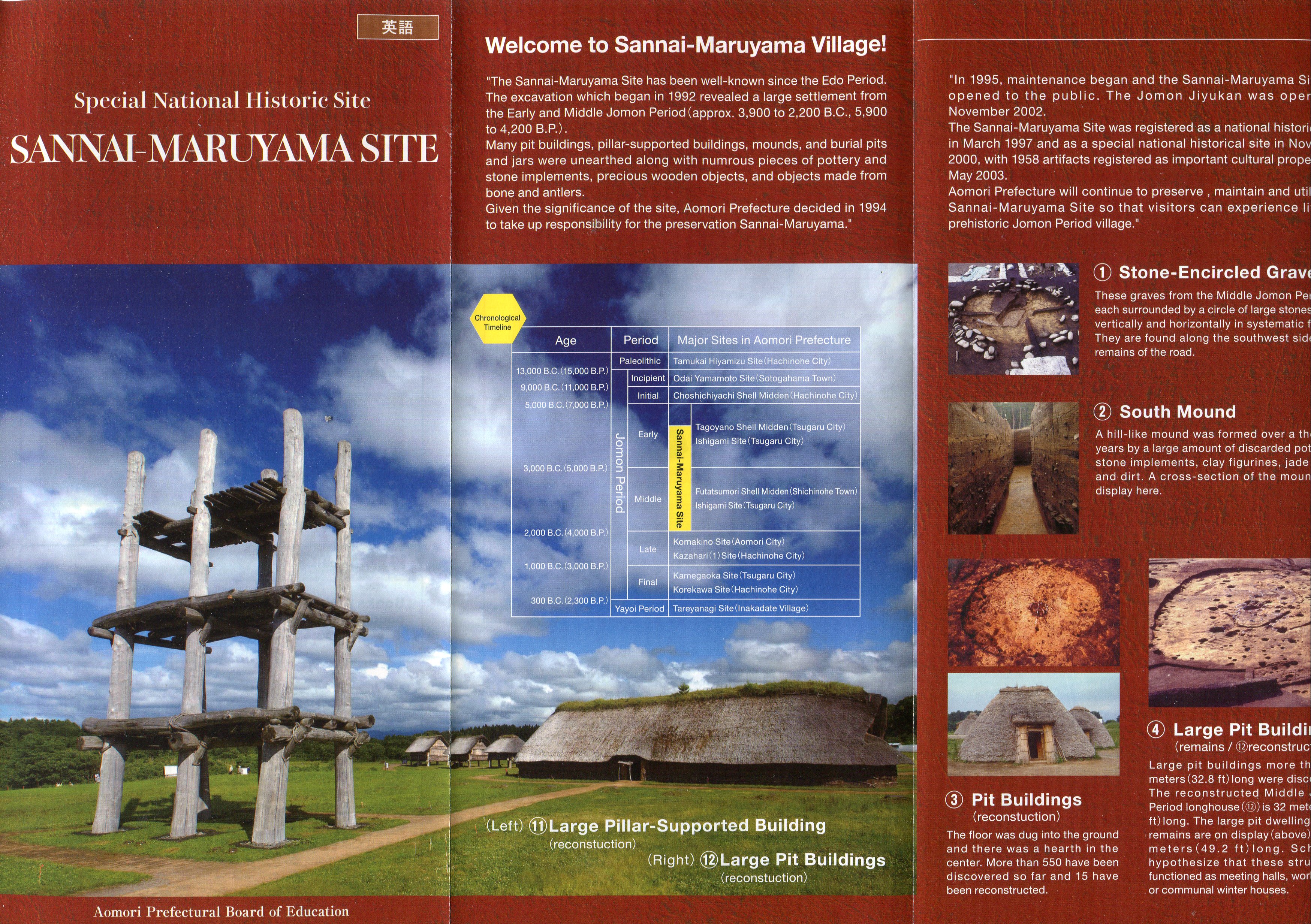
The pamphlet of Sannnai Maruyama site introducing the famous six-pillar reconstructed building. Purpose of the building is unknown
We had booked a rental car which we picked up at Aomori Airport and headed north west to Tsugaru City. Of the approximately fifty kilometers’ drive, half of the way was a free motorway, which was most convenient. The problem was to find somewhere to have lunch, as there were no service areas on the motorway, nor any roadside chain-store restaurants. We were lucky to find a roadside Japanese restaurant very close to our first destination, the Kamegaoka Jomon settlement site. They served a relatively large number of popular lunch dishes gathering from the menu on the wall. One dish, kai-miso caught my attention. Kai means shellfish, which Aomori is famous for especially scallops. I asked the waitress if this was a local dish. “Yes. It’s scallops, eggs and leek stewed on a scallop shell. You may find it a bit salty.” I wanted to try local dishes and ordered the kai-miso. It was a dish that I had never experienced. The chopped scallop and beaten egg stewed with local miso paste made a delightful combination. It was indeed a bit salty, making it a good partner with rice or sake in the evening. I was happy with my selection, as I came across the dish on several occasions and my first try served as a yardstick.
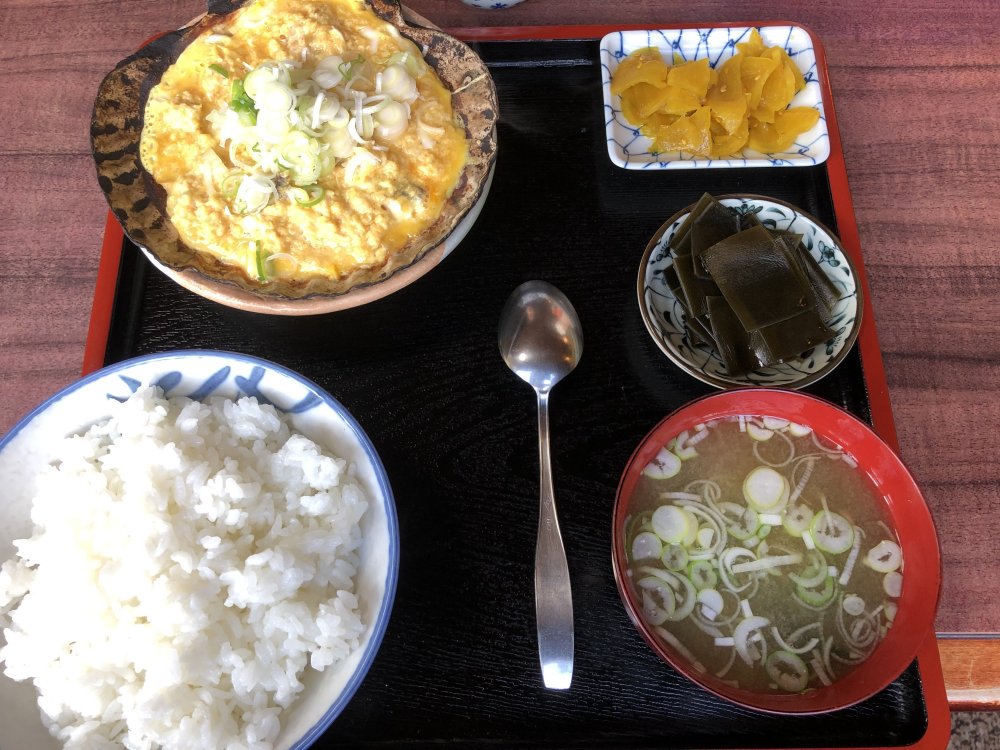
I ordered a local dish "kaimiso". The chopped scallop and beaten egg stewed with local miso paste made a delightful combination. It was indeed a bit salty, making it a good partner with rice or sake in the evening.
We went to the Kamegaoka Jomon site, only a one minute drive from the restaurant. There was only one other car when we parked at the car park by the side of the Jomon site. A notice on the window of a small wooden building in the car park told us that there were no tour guides due to Covid 19 but that we were free to enter the building and help ourselves to the brochures and leaflets. The site map including the surrounding area was very helpful.
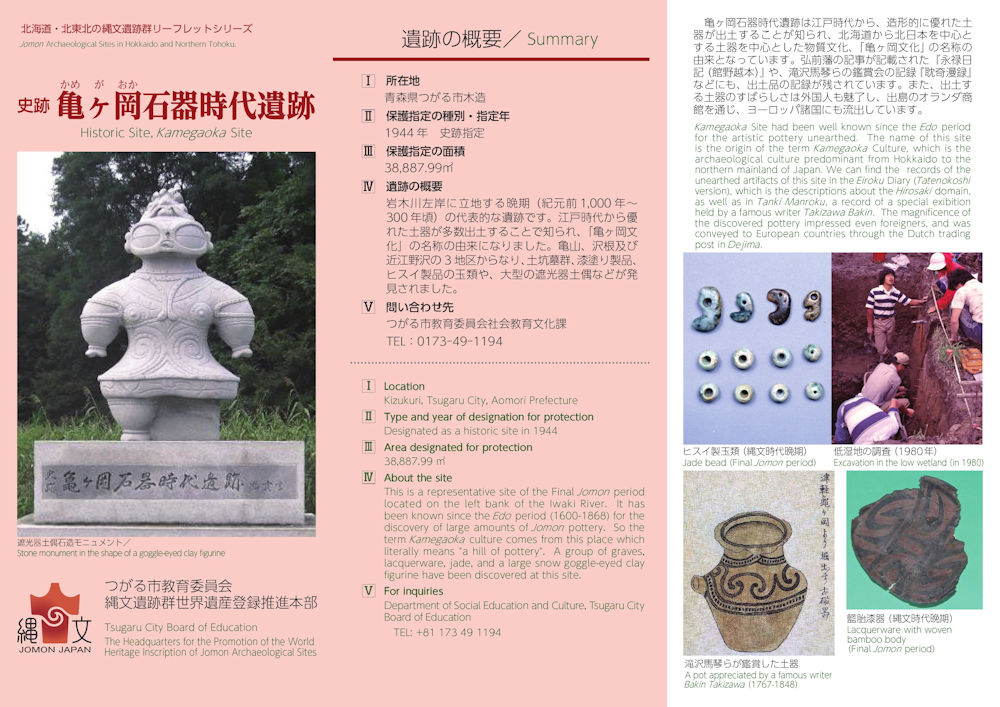
The leaflet introducing the Kamegaoka site in both Japanese and English.
I had long wanted to visit this site as I had learned of a goggle-eyed clay figurine unearthed here which together with the pottery and other artifacts found here have led to the naming of Kamegaoka Culture, which was the Jomon culture that flourished in the Tohoku region at the final centuries of Jomon period to around 300 B.C. There is not much to see at the park by the car park along the main road except for a monument of the goggle-eyed clay figurine and a public convenience.
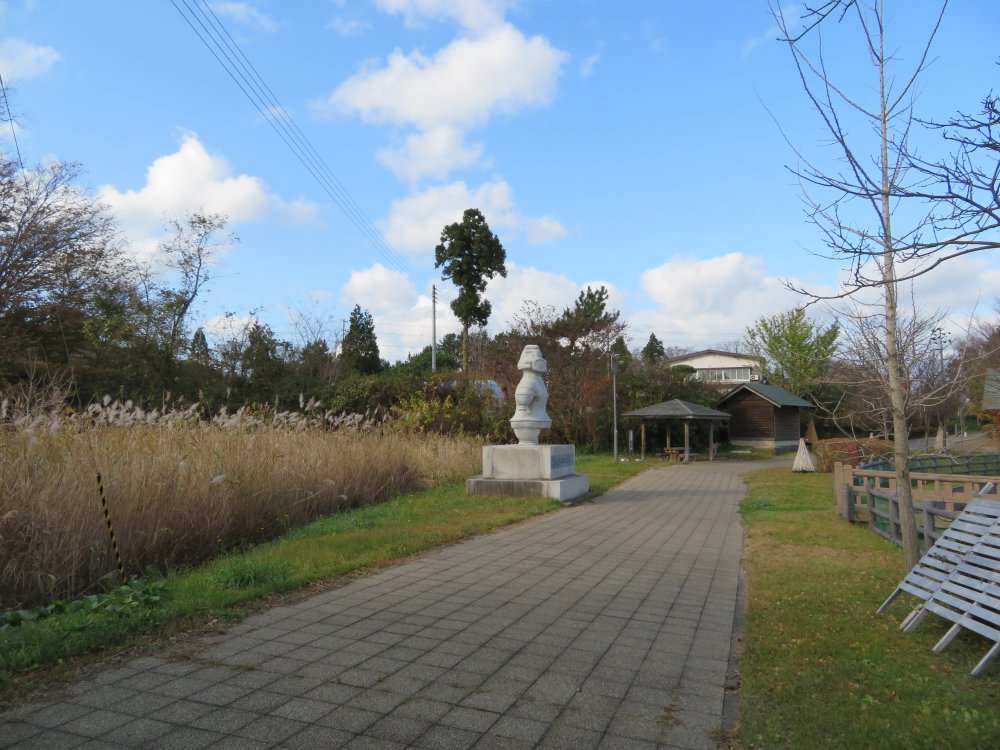
There is not much to see at the park by the car park along the main road except for a monument of the goggle-eyed clay figurine and a public convenience.
Aided by the local area map, we went uphill into the woods and followed the suggested trail. The trail first took us to the “dumping ground in the lowland swamps” which was where the goggle-eyed clay figurine was found, followed by the “pit graves in the north tip of the plateau” where 45 pit graves (round or oblong pits dug in the ground to bury the dead) in the archaeological excavation in 2017.
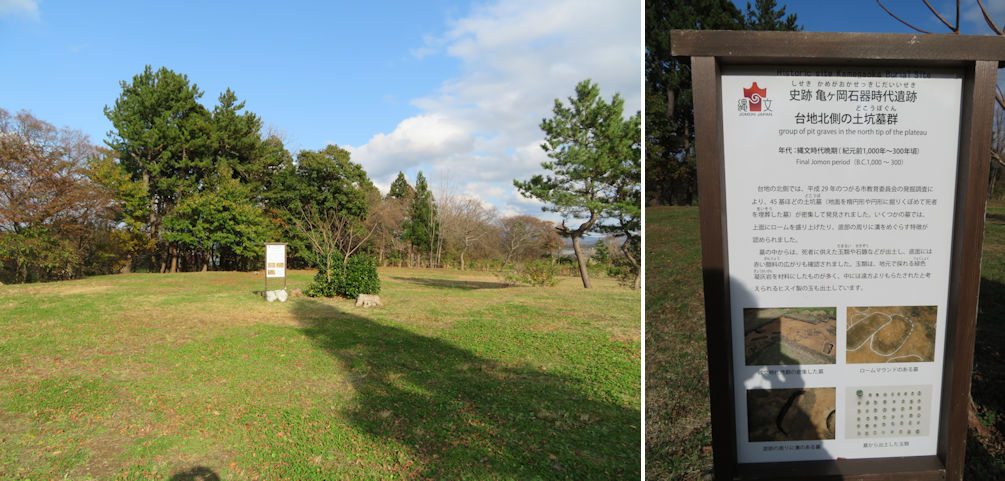
View of the “pit graves in the north tip of the plateau” where 45 pit graves (round or oblong pits dug in the ground to bury the dead) in the archaeological excavation in 2017 (left). Description of the grave pits was in English as well as Japanese (right).
We went into a path leading to the south. It had been a gradual climb from
the main road where we had parked. Obviously, we were now on a plateau,
a typical place for a Jomon settlement. The next place was the “pit graves
in the south tip of the plateau” where we learnt that 20 pit graves had
been found in a much earlier excavation in 1982. Interestingly, the pit
graves area was lying in front of a Shinto torii gate. There was a Shinto
shrine right in between the pit graves in the north and the ones in the
south. I have become increasingly convinced that the origin of Shintoism
must be related to the belief of the Jomon people.
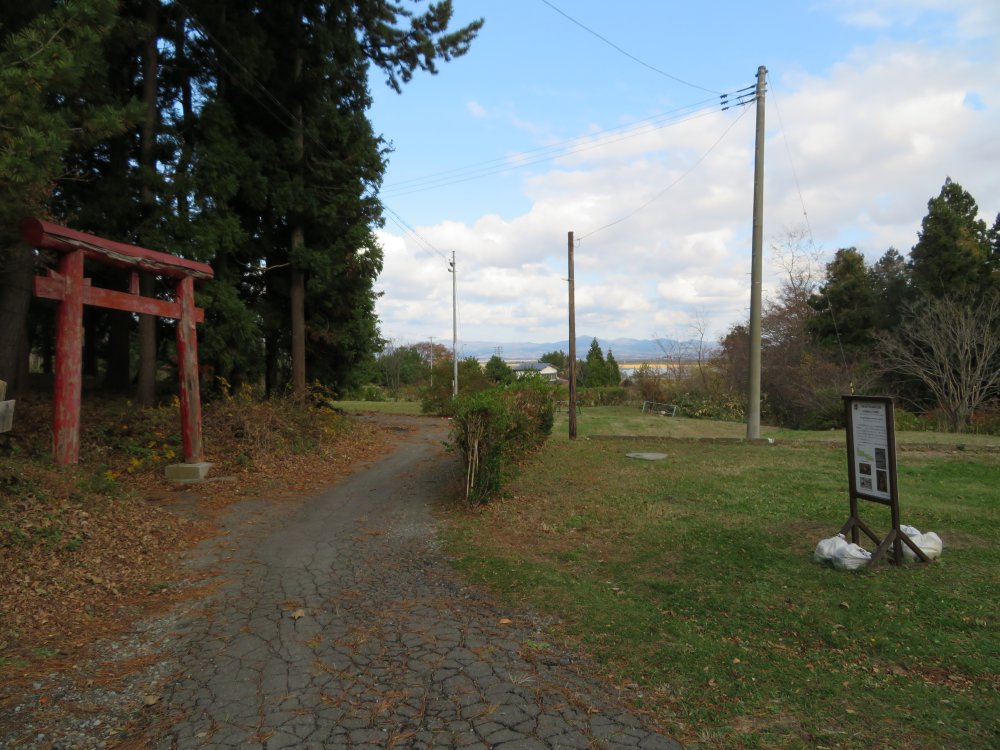
Interestingly, the pit graves area was lying in front of a Shinto torii gate. There was a Shinto shrine right in between the pit graves in the north and the ones in the south. I have become increasingly convinced that the origin of Shintoism must be related to the belief of the Jomon people.
The path we had entered circled back to the road we had left. We found here the site of a much earlier site dating back to 4000 to 2500 B.C., the early and middle Jomon periods. This site was discovered in the excavations in 2018 and 2019. Until then Kamegaoka had been believed to be a settlement site in the late Jomon period (1000 to 300 B.C.). The explanation on the site told us that this was the site of “pit dwellings and storage pits in the north tip of the plateau” and that by this discovery it is now understood that people had lived on this plateau for a much longer period than thought before.
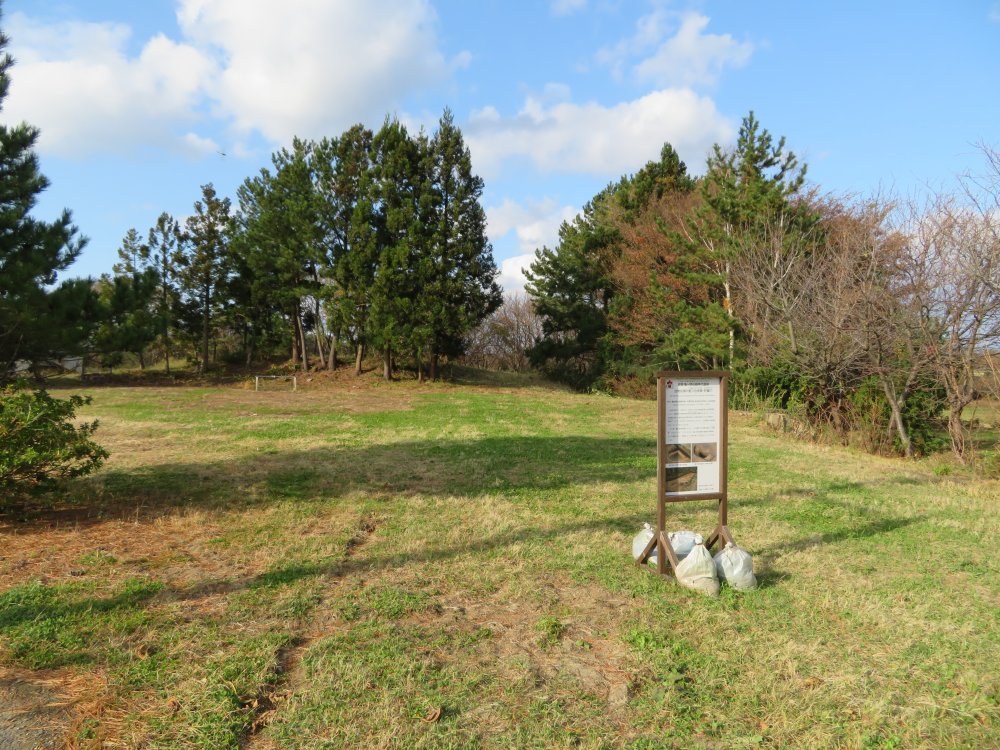
The explanation on the site told us that this was the site of “pit dwellings and storage pits in the north tip of the plateau” and that by this discovery it is now understood that people had lived on this plateau for a much longer period than thought before.
We picked up our car back at the car park and drove to our next destination, which was the Kamegaoka Archaeological Archives (Kizukuri Kouko Shiryoukan) a couple of minutes away by car. There are only a handful of Jomon sites with an adjacent museum in Aomori at present, although this might change if the Jomon sites in Hokkaido and Aomori are designated as World Heritage sites. In any event I had planned this trip around sites with museums, as usually that is much more informative. We finally found the building, which was in the middle of the woods and part of an agricultural training center. My advice to those wishing to follow the Jomon trail in Aomori is to take a car.
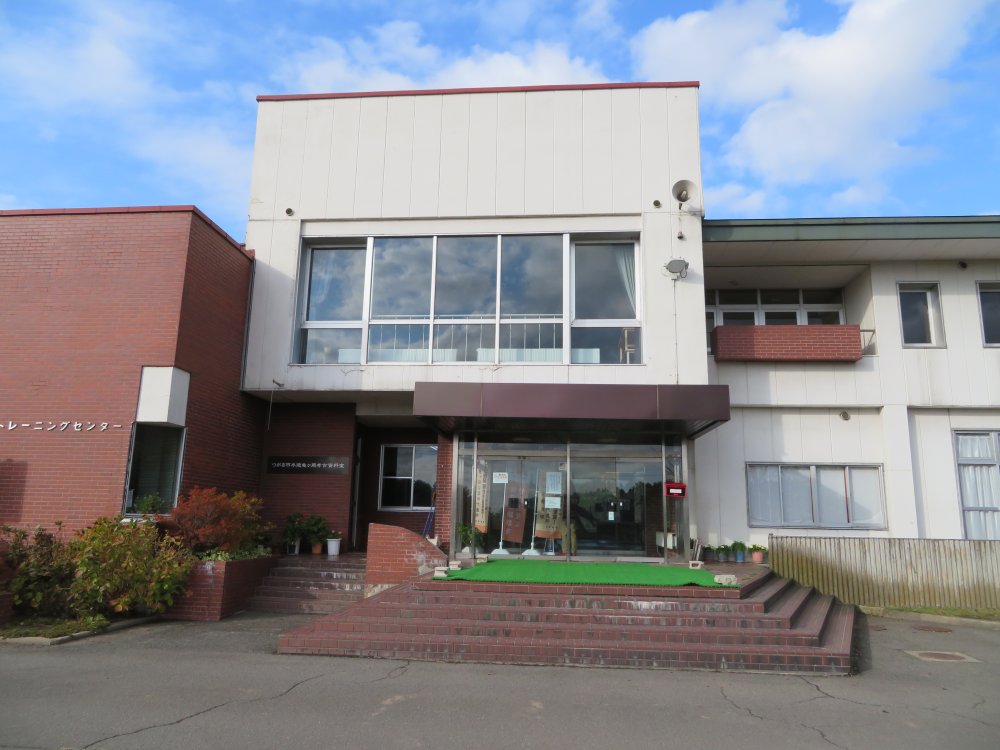
We finally found the Kamegaoka Archaeological Archives (Kizukuri Kouko Shiryoukan), which was in the middle of the woods and part of an agricultural training center.
The existence of the Kamegaoka site was known from the 17th century, when pottery and other artefacts were found in the course of an attempt to build a castle. Archaeological excavations started shortly after the Meiji Restoration (1868), and the goggle-eyed clay figurine was found in 1886. It is a pity that vast artefacts were taken away (some found their way outside Japan) and became private property. The goggle-eyed clay figurine was designated as a national important cultural property and displayed at the Tokyo National Museum. The Kamegaoka Archives Display was opened in 1979 and displays privately owned artefacts that remain in Aomori. Admission fee is 200 yen. All the displays are in one room, and the displays include various pottery, tools and accessories. One main feature is a lacquerware with a woven bamboo body from the late Jomon Period. It didn’t take us long to browse the displays.
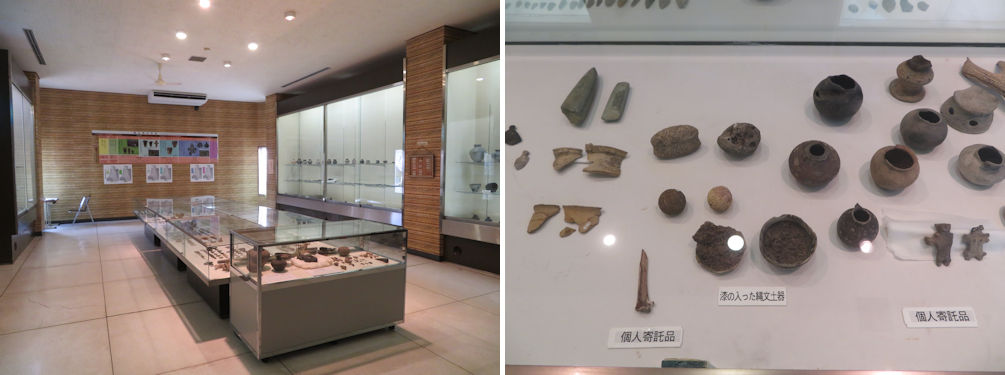
The display room in the Kamegaoka Archaeological Archives (Kizukuri Kouko Shiryoukan) (left).The earthenware in the middle are lacquerware.
On our way back to Aomori City, we came across another museum related to the Kamegaoka site, the Jomon Dwelling Exhibit Museum close to the Tsugaru City Office. I wondered why it was also named Karuko in katakana characters. I learned afterwards that it was an abbreviation for Kamegaoka Archaeological Collections (KARCO), although I’m sure very few people would guess where it came from. In any event, I understand the museum opened in 1987 houses artefacts found at numerous sites in Tsugaru City including those from the Kamegaoka site. We paid the admission fee of 200 yen at the admission office. We got a distinct feeling that we were not that welcome judging from the face of the lady at the admission office. Throughout our three-days excursion, all the museums had few visitors, and the curator would be more than willing to accompany us and feed us with a lot of information. This museum was completely different from the others. Perhaps it was because we arrived at around 16:00 just before the last admission time of 16:30 and closing time of 17:00. On the ground floor was a 70% scale reconstructed Jomon dwelling replicated from remnants of a dwelling site in Hirosaki City. Nothing special, but it does give the modern museum a feel of the Jomon.
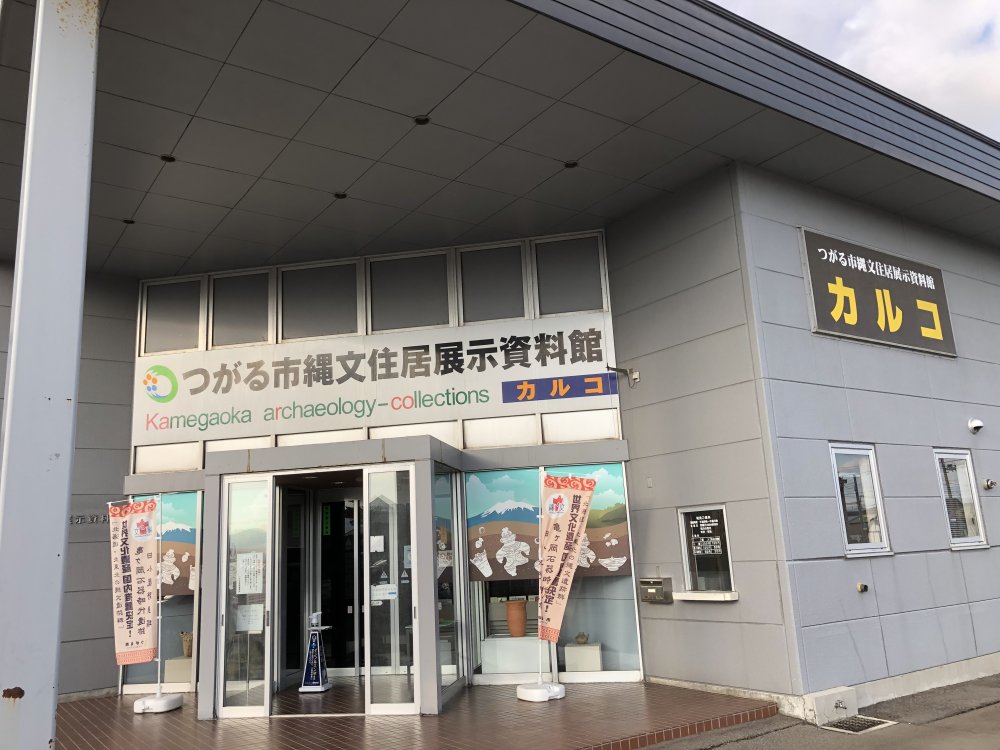
On our way back to Aomori City, we came across another museum related to the Kamegaoka site, the Jomon Dwelling Exhibit Museum close to the Tsugaru City Office.
We went to the main display area on the second floor. There were only two visitors apart from us. The displays of pottery covered the period from the early Jomon (roughly 10000B.C.) to late Jomon (roughly 400 B.C.), so it was interesting to understand how pottery had developed. Generally, the displays were arranged by the archaeological sites where they had been excavated. We headed back towards Aomori City.